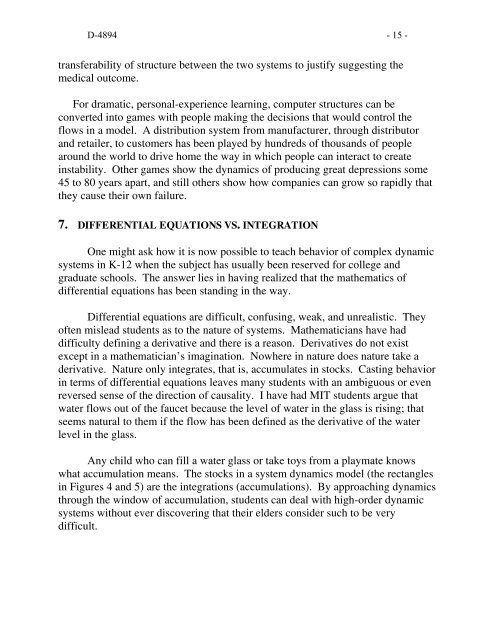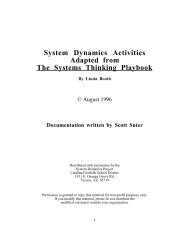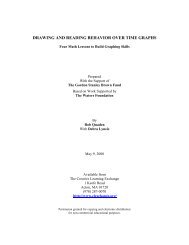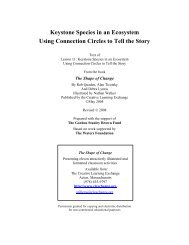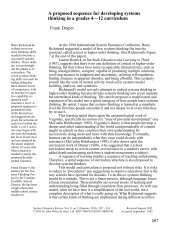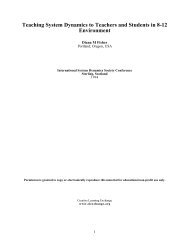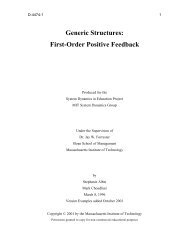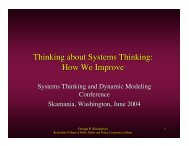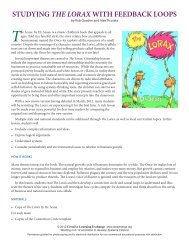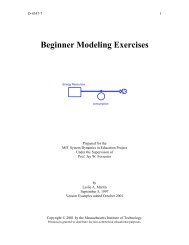Some Basic Concepts in System Dynamics - Creative Learning ...
Some Basic Concepts in System Dynamics - Creative Learning ...
Some Basic Concepts in System Dynamics - Creative Learning ...
You also want an ePaper? Increase the reach of your titles
YUMPU automatically turns print PDFs into web optimized ePapers that Google loves.
D-4894 - 15 -transferability of structure between the two systems to justify suggest<strong>in</strong>g themedical outcome.For dramatic, personal-experience learn<strong>in</strong>g, computer structures can beconverted <strong>in</strong>to games with people mak<strong>in</strong>g the decisions that would control theflows <strong>in</strong> a model. A distribution system from manufacturer, through distributorand retailer, to customers has been played by hundreds of thousands of peoplearound the world to drive home the way <strong>in</strong> which people can <strong>in</strong>teract to create<strong>in</strong>stability. Other games show the dynamics of produc<strong>in</strong>g great depressions some45 to 80 years apart, and still others show how companies can grow so rapidly thatthey cause their own failure.7. DIFFERENTIAL EQUATIONS VS. INTEGRATIONOne might ask how it is now possible to teach behavior of complex dynamicsystems <strong>in</strong> K-12 when the subject has usually been reserved for college andgraduate schools. The answer lies <strong>in</strong> hav<strong>in</strong>g realized that the mathematics ofdifferential equations has been stand<strong>in</strong>g <strong>in</strong> the way.Differential equations are difficult, confus<strong>in</strong>g, weak, and unrealistic. Theyoften mislead students as to the nature of systems. Mathematicians have haddifficulty def<strong>in</strong><strong>in</strong>g a derivative and there is a reason. Derivatives do not existexcept <strong>in</strong> a mathematician’s imag<strong>in</strong>ation. Nowhere <strong>in</strong> nature does nature take aderivative. Nature only <strong>in</strong>tegrates, that is, accumulates <strong>in</strong> stocks. Cast<strong>in</strong>g behavior<strong>in</strong> terms of differential equations leaves many students with an ambiguous or evenreversed sense of the direction of causality. I have had MIT students argue thatwater flows out of the faucet because the level of water <strong>in</strong> the glass is ris<strong>in</strong>g; thatseems natural to them if the flow has been def<strong>in</strong>ed as the derivative of the waterlevel <strong>in</strong> the glass.Any child who can fill a water glass or take toys from a playmate knowswhat accumulation means. The stocks <strong>in</strong> a system dynamics model (the rectangles<strong>in</strong> Figures 4 and 5) are the <strong>in</strong>tegrations (accumulations). By approach<strong>in</strong>g dynamicsthrough the w<strong>in</strong>dow of accumulation, students can deal with high-order dynamicsystems without ever discover<strong>in</strong>g that their elders consider such to be verydifficult.


